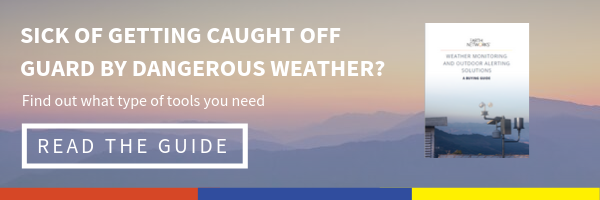3 Things you Should Know About Indirect Lightning Strikes
- Sep 13, 2019
What are Indirect Lightning Strikes?

Close your eyes and picture a lightning strike. You’re probably imagining dark storm clouds with a flash of light meeting the tallest thing around, like a building or tree.
But did you know lightning also strikes the ground beneath your feet?
Indirect lightning strikes, or strikes that discharge their electricity into the ground, aren’t as well-known but they are very powerful.
Let’s learn a little more about them so you can protect yourself from every type of lightning strike during the next thunderstorm.
You can also protect yourself by using tools, like a lightning alert horn and strobe system powered by a total lightning network.
3 Things You Need to Know

1. The Difference Between Direct and Indirect Lightning Strikes
There is one main difference between direct lightning strikes and indirect lightning strikes, and it’s related to the way they travel.
A direct lightning strike occurs when all the lightning’s energy is directed through the body or over the body on the skin.
An indirect lightning strike can happen two different ways.
The first way is through a ground current. These occur when lightning strikes an object or the ground and the electricity travels through the ground until it encounters another object.
The second way is through a side flash. This happens when lightning strikes an object that seeks a path that lets it jump through the air to a second object.
For example, lightning could strike an airplane on the tarmac and leap through the air as a side flash to hit a nearby ground crew worker, causing serious injuries and even death. Airports face several threats from lightning.
2. Indirect Lightning Strikes Can Kill
According to NOAA, an average bolt of lightning carries 20,000 to 30,000 amperes of charge and about 300 million volts. Direct lightning strikes are more dangerous, but both can be incredibly damaging. Both types of strikes have enough power to kill.
In 2016, an indirect lightning strike that hit the ground in Norway killed over 300 reindeer. The electricity traveled through the ground and killed the animals during a thunderstorm. The total death toll was 323. This is just one of the many examples of the deadly powers of indirect lightning strikes.
3. Indirect Lightning Strikes are More Common
In fact, direct lightning strikes only make-up about 4% of all reported strikes. Indirect lightning strikes, which produce ground currents, account for about 50% of lightning injuries. Since these strikes happen a lot, it’s a good idea to be prepared for them and know when lightning is in your area.
Lightning is also a very common event. In fact, there were more than 19 million cloud-to-ground lightning strikes in the U.S. alone in 2019.
A Scary Indirect Lightning Strike Incident
On Monday, July 10, 2017, a swim instructor was on her way to work when an indirect strike sent electricity through her body.
She was walking in the parking lot of the Lauderdale Lakes Swimming Pool Complex when the incident occurred. The 27-year-old woman was carrying an umbrella as she walked through the thunderstorm to the entrance of the building.
The video below shows the incident and the instructor’s reaction.
New video shows moment swim instructor was jolted by lightning @CBSMiami pic.twitter.com/Iop8YJRHas
— Miguel Fernandez (@miguelcbs4) July 10, 2017
Luckily, the jolt of lightning did not seriously injure the instructor. She was able to get up and enter the building. Later, a nearby hospital treated her for minor injuries.
This swim instructor got lucky. Sometimes, indirect lightning strikes are dangerous or even deadly. Six guests at the PGA Championship Tour learned that the hard way when lightning struck a nearby tree. Luckily, all six victims survived.
Indirect Lightning Strike Protection
Does your organization worry about protecting visitors, employees, or infrastructure from lightning strikes?
If it does, then you most likely have thought about lightning alerts before.
How do you know which system is the best one to safeguard what matters to you most from severe weather? We’ve got you covered.
Download our Outdoor Alerting System Buying Guide to find out all the features you should look for when you decide that lightning is a priority at your organization.








